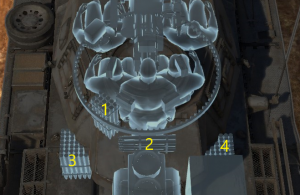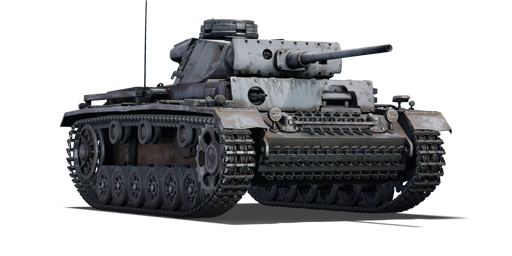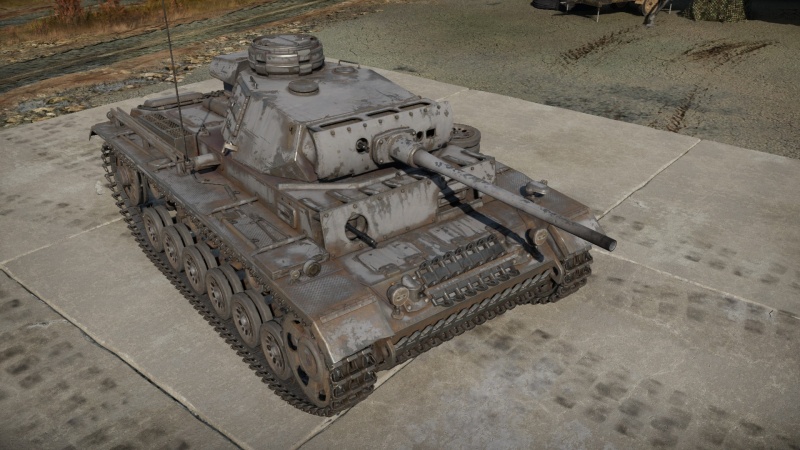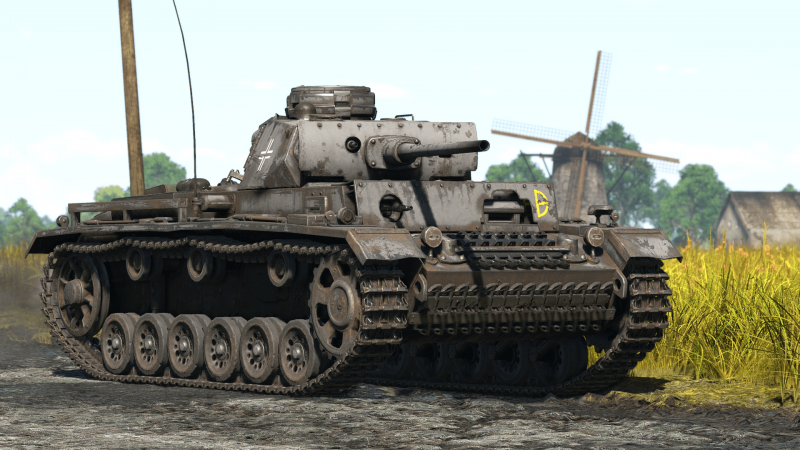Pz.III L
| This page is about the German medium tank Pz.III L. For other versions, see Panzer III (Family). |
Contents
Description
The Panzerkampfwagen III Ausführung L (Panzer III L) (Sd.Kfz. Index: Sd.Kfz. 141/1) was the tenth variant of the Panzerkampfwagen III medium tank family (the "I" variant was skipped). It is essentially a newly manufactured Panzer III based on Panzer III J1 standards, which was modified from existing Panzer III Js. Both the turret and the frontal hull were outfitted with spaced armour. It was also outfitted with a new system for transferring heated engine coolant to another vehicle. However, distinguishing the different variations based on the look of spaced armour on Panzer IIIs is not a viable method. The front of the turret and the hull of the latest production Panzer IV J tanks were fitted with 20 mm spaced armour plates. Some older Panzer III variants also had it fitted in the field.
Introduced in the Closed Beta Test for Ground Forces before Update 1.41, the Panzer III L is armed with the same long-barrelled 50 mm L/60 anti-tank gun as the preceding Panzer III J1, but it also has 20 mm spaced armour on the front of the turret and hull. The Panzer III L's playstyle is essentially the same, however, players may appreciate the small upgrades in frontal protection. Frontal engagement with tanks that fire HEAT ammunition, such as the M4A3 (105) is easier because the 20 mm spaced armour limits the efficacy of the HEAT projectiles when attacked from the tank front. Nonetheless, the armour upgrade is insufficient for aggressive battle, and caution is still required, particularly against Soviet early T-34 medium tanks and early KV-1 heavy tanks.
General info
Survivability and armour
Armour type:
- Rolled homogeneous armour
- Cast homogeneous armour (Cupola)
- High hardness rolled armour (Appliqué armour)
| Armour | Front (Slope angle) | Sides | Rear | Roof |
|---|---|---|---|---|
| Hull | 50 + 20 mm (12°) Front plate 25 mm (85°), 50 mm (52°) Front glacis 50 mm (25°) Lower glacis |
30 mm | 50 mm | 15 mm |
| Turret | 57 mm + 20 mm Turret front 50 + 20 mm Gun mantlet |
30 mm | 30 mm | 10 mm |
| Cupola | 50 mm | 10 mm |
Notes:
- It has 50 mm of armour at the front of the hull and 57 mm on the turret front, but there is an additional 20 mm plate on the upper hull and at the front of the turret, increasing the effective armour to 70 mm and 77 mm respectively. When the armour is angled, this tank becomes very strong frontally.
- The strong turret armour makes this tank powerful when hull-down, as many enemies will only be able to penetrate your cupola, only knocking out the commander. However, don't allow anyone to freely fire there, as some unlucky shot fired there can still occasionally cause severe damage.
- The side and rear armour of the tank are thin, but it is possible to bounce shots from the side armour if it is angled steeply while side-scraping.
- Suspension wheels are 15 mm thick while tracks are 20 mm thick.
Panzer III L has pretty good frontal armour, but there are several weak spots - around the driver's viewport and machinegun port, and few small spots on the turret, where armour is only 50 mm thick and completely flat, aim there. Sides and rear are very thin, if you can target these areas (even under quite a high angle), they are penetrable very easily. If you have powerful enough gun, you can try to outgun it from afar, where its own 5 cm gun will struggle with penetration.
Mobility
| Game Mode | Max Speed (km/h) | Weight (tons) | Engine power (horsepower) | Power-to-weight ratio (hp/ton) | |||
|---|---|---|---|---|---|---|---|
| Forward | Reverse | Stock | Upgraded | Stock | Upgraded | ||
| Arcade | 60 | 12 | 22.5 | 465 | 572 | 20.67 | 25.42 |
| Realistic | 54 | 10 | 265 | 300 | 11.78 | 13.33 | |
The Panzer III L is a relatively mobile tank compared to many of its opponents, allowing it to flank it situations where going head-on may not be safe, although it is not nearly as fast or mobile as light tanks of the same level. This mobility is best used to place pressure on a crippled opponent, or quickly capture an objective.
Modifications and economy
Armaments
Main armament
| 50 mm KwK39 | Turret rotation speed (°/s) | Reloading rate (seconds) | |||||||||||
|---|---|---|---|---|---|---|---|---|---|---|---|---|---|
| Mode | Capacity | Vertical | Horizontal | Stabilizer | Stock | Upgraded | Full | Expert | Aced | Stock | Full | Expert | Aced |
| Arcade | 84 | -10°/+20° | ±180° | N/A | 13.3 | 18.4 | 22.4 | 24.8 | 26.4 | 4.81 | 4.25 | 3.92 | 3.70 |
| Realistic | 8.3 | 9.8 | 11.9 | 13.2 | 14.0 | ||||||||
Ammunition
- PzGr 39 - Armour Piercing Capped shell - This is your main ammo type, use it whenever you think it has enough penetration to penetrate your target. It deals the most damage, because of its explosive filler. It also offers the best penetration at very long range (over 1500 m), combat at this range is however not recommended.
- PzGr 40/1 - Armour Piercing Composite Rigid shell - This type of ammo should be used if you are having trouble penetrating your opponent, or trying to hit a fast-moving tank at some distance. However, its damaging potential is much lower, because it has no explosive filler to further enhance damage after the penetration. It should be used only at close range, at medium range, PzGr 40 is better.
- PzGr 40 - Armour Piercing Composite Rigid shell - this variation of APCR is lighter, slightly faster and offers the best penetration. Use it against heavily armoured tanks like KV-1 (If you can't flank them). However, don't expect it to cause any real damage upon penetration, its even worse than that of PzGr 40/1. It basically only deals damage to modules/crew straight in its path. It is therefore almost useless to fire them at things like turret cupolas, as it will usually just fly right through them.
- SprGr 38 - High Explosive shell - You should carry only very few of these. They are completely useless against anything other than unarmoured AA vehicles, to which it is lethal. It can be useful as the vehicle lacks an AA machine gun on the turret roof, and the coaxial MG is not the most efficient.
| Penetration statistics | |||||||
|---|---|---|---|---|---|---|---|
| Ammunition | Type of warhead |
Penetration @ 0° Angle of Attack (mm) | |||||
| 10 m | 100 m | 500 m | 1,000 m | 1,500 m | 2,000 m | ||
| PzGr 39 | APC | 106 | 101 | 83 | 65 | 50 | 39 |
| PzGr 40/1 | APCR | 130 | 121 | 90 | 62 | 43 | 29 |
| PzGr 40 | APCR | 137 | 126 | 88 | 56 | 36 | 23 |
| Sprgr. 38 | HE | 12 | 11 | 9 | 7 | 6 | 5 |
| Shell details | ||||||||||||
|---|---|---|---|---|---|---|---|---|---|---|---|---|
| Ammunition | Type of warhead |
Velocity (m/s) |
Projectile mass (kg) |
Fuse delay (m) |
Fuse sensitivity (mm) |
Explosive mass (TNT equivalent) (g) |
Ricochet | |||||
| 0% | 50% | 100% | ||||||||||
| PzGr 39 | APC | 835 | 2.05 | 1.2 | 9 | 28.9 | 48° | 63° | 71° | |||
| PzGr 40/1 | APCR | 1,130 | 1.07 | - | - | - | 66° | 70° | 72° | |||
| PzGr 40 | APCR | 1,180 | 0.9 | - | - | - | 66° | 70° | 72° | |||
| Sprgr. 38 | HE | 870 | 1.82 | 0.4 | 0.1 | 217.6 | 79° | 80° | 81° | |||
Ammo racks

| Full ammo |
1st rack empty |
2nd rack empty |
3rd rack empty |
4th rack empty |
Visual discrepancy |
|---|---|---|---|---|---|
| 84 | 70 (+14) | 62 (+22) | 34 (+50) | 1 (+83) | No |
Turret empty: 62 (+22)
Machine guns
| 7.92 mm MG34 | ||||
|---|---|---|---|---|
| Mount | Capacity (Belt) | Fire rate | Vertical | Horizontal |
| Coaxial | 3,750 (150) | 900 | N/A | N/A |
Usage in battles
This tank is very versatile as it can do head on engagements, it's good at flanking, and features a rapid-firing 50 mm gun with excellent penetration capability compared to the other nations' medium tanks at similar battle rating. When it comes to the tanks survivability, it's best to keep a reasonable distance to the enemy target to keep the enemies gun out of a solid penetration range. The additional 20 mm frontal plate on the Panzer III L version makes its survivability much higher at long range combat compared to the older J1 version.
The box shaped armour with no angle makes it an easy target to penetrate so be advised to angle the frontal armour or go full throttle and try to flank the enemy. The Pz III L got a decent turret rotation in case it is forced into a close quarters battle with an enemy tank, but keep in mind that distance with the tank is preferable. Though it can take on most tanks in a head on battle and distance battles makes it a very versatile tank to use in most kinds of situations one will happen to get into when playing with it.
The Panzer III L's long 50 mm cannon is no laughing matter, with its high rate of fire it can be deadly to enemy opponent if it gets the first shot, with a reliable gun that can corner most enemy tanks at 2.0-4.0 BR range. It will penetrate most enemy tanks, though there are some that require more careful aiming in order to be successful, mostly tanks like M4 Shermans, M10/Achilles, T-34s, ARL-44 (ACL-1), KV-1s and Churchills. Angled armoured tanks like the M4, M10/Achilles, T-34 can possess a certain difficult reliability for the 50 mm gun to penetrate them with ease. Churchill have no angled armour but can still pose a threat to the tank with its heavier armour compared to the medium and light tanks. ARL-44 (ACL-1) and the KV-1 get both heavy and angled armour and will be a tricky opponent to face for the Panzer III's 50 mm gun but they still are not impossible opponents to defeat. In these situations, it is best to use the manoeuvrability of the Panzer III to flank them and attack their sides, although it may be best to avoid KV-1s altogether due to their heavy side armour.
With the speed of the Panzer III, it can outmanoeuvre heavier tanks with ease and flank around them for an easier killing shot if it experiences problems with the enemy frontal armour. It might not be as fast as a light tank, but a top speed of 53 km/h (33 mph) makes the second fastest medium tank at its battle rating. With speed as excellent on this fast medium tank, flanking will not be a problem for it to do.
- US M4 Shermans have decent strong frontal armour but with angle increasing its survivability against the L/60 gun to be penetrated reliably, especially the HVSS versions are tricky opponents if not knowing how to aim. In close combat the Sherman has the advantage over the Panzer III with its 75 mm gun and angled armour.
- All mentioned USSR tanks have tricky hull armour and can be impenetrable for the L/60, as well as being able to destroy the Panzer III with one well-aimed shot. Avoiding direct confrontation is logical against this kind of enemy. Leave them to your better-armed allies, try to flank them, or aim for weak spots. Use some range to increase the effectiveness of your own armour.
- Pz.IVs and StuGs outgun you at all ranges, you can exchange fire with them or flank them, but they are at an advantage with their long 75 mm cannons. StuG III G can be harder to penetrate.
Pros and cons
Pros:
- Strong frontal armour thanks to the additional 20mm high hardness plates. Angling betters it
- Fast for a medium tank
- Rapid fire gun, good for shooting sides and rear
- Shells travel fast, making it easier to aim and lead at long distance
- Excellent -10° gun depression is suitable for hilly terrains
- Small and well-located ammo racks - the tank is very rarely destroyed by being ammo racked, unlike Pz.IVs
- Winterketten help with navigating rough terrain while retaining mobility
Cons:
- Gun is unreliable when facing certain tanks frontally (T-34s, KV-1, M4s) unless one aims for weak spots or uses the PzGr 40 (APCR) shell
- Gun is bad for long-range combat
- APCR rounds have a poor post-penetration effect
- Armour isn't 70 mm thick at the entire front - machine gun port and the driver viewport are weak spots
- Turret ring is prone to get damaged, even by non-penetrating hits
- Large and vulnerable commander cupola
History
Development
The Panzerkampfwagen III medium tank or the Panzer III was developed in the 1930s. Starting in early 1934, Heinz Guderian set down some specifications for a new tank, which Army Weapons Department took up to design the tank to weigh no more than 24,000 kilograms with a top speed of 35 km per hour. This tank's role was to be the main tank of the German army and was expected to destroy opposing tanks, as opposed as a tank made to destroy anti-tank guns and opposing infantrymen, which the Panzer IV took up in.
Daimler-Benz, Krupp, MAN, and Rheinmetall produced prototypes meeting the specifications and the Daimler-Benz model was chosen after testing in 1936-1937. The Panzer III model used a leaf-spring suspension in its early models (Ausf. A - Ausf. D) before utilizing a six-wheeled torsion-bar suspension in the Ausf. E and beyond. The Panzer III had a crew of five people, the commander, gunner, loader, driver, and assistant driver. The best feature of the Panzer III during its introduction that is the most overlooked was the three-man turret, which was not as common at the time. This frees the commander to be able to effectively command the tank while maintaining situational awareness rather than be burdened by the role of a loader or gunner, improving the combat effectiveness of the tank. Despite this rather advanced design, the turret did not have a turret basket for the crew. It was a proven design and production began in May 1937. The total number of Panzer IIIs tanks constructed in its production life was 5,774 units (excluding StuG III variant).
Specifications
The Panzer III Ausf. L has the improved 50 mm KwK 39 as its main armament, giving it the firepower to go against the better Allied tanks T-34s and M4 Shermans. The Panzer III Ausf. L featured the armour finalized on the Ausf. J1, with 50 mm of hull armour and offset armour on the front of the hull and turret that is 20 mm effective. This armour also is applied as spaced armour due to not being attached to the hull or turret mantlet. The spaced armour on the front helped defend the tank against Soviet anti-tank rounds or HEAT rounds fired at it on those plates, as it dissipates the penetration power before striking the hull.
Combat usage
Despite its newer aspects compared to older Panzer IIIs, the prevalence of newer German tanks such as the Tiger I and Panther tanks, plus the establishment upgunned Panzer IVs made these more able to take on Allied tanks than the Panzer III. The Panzer III began slowly to be relegated to secondary roles such as training or anti-partisan activities. Nevertheless, the Panzer IIIs proved a versatile armoured platform in German service, as even though it was obsolete in late 1941, it was constantly upgraded with better guns, better protection, or modified completely to fit a different role more efficiently than its original. Even when phased out of service, its chassis was used as the basis of Germany's most lethal tank destroyer, the StuG III.
The Panzer III at this time was given one more upgrade in its armour into the variant Panzer III Ausf. M, which featured the new Schürzen armour skirts.
| Archive of the in-game description | |
|---|---|
|
Production of the Pz.Kpfw. III light tank, Ausf. L variant began in June 1942. For a few months prior to this date, the military had experimented with installing the turret from the Pz.Kpfw. IV on this tank. This allowed the use of the long-barreled 75 mm KwK43 tank gun. However, this test proved unsuccessful, and in the spring of 1942, the armament department ordered the production of a variant equipped with the 5 cm KwK39 L/60, but including all of the changes that had been made during the attempts to install the turret from the Pz.Kpfw. IV. Because of this, the weapon mantlet, which also served as the weapon's counterweight, had to be reinforced. An additional 20 mm front armour plate became standard design. Pz. III Ausf. L tanks received 57 mm of frontal turret armour, along with the installation of a torsion counterbalance for the gun instead of a coil spring. This resulted in a decrease of the ammunition carried for the gun. This variant received a 20 mm spaced armour plate in the forward part of the hull's superstructure. A coolant transfer system was installed which could move warm coolant fluid from one tank to another, making the cold tank easier to start in winter conditions. Later, the track adjusters were upgraded, and the smoke bombs were relocated to a position under the rear of the tank. Additional protection was achieved by removing the observation slits from the sides of the turret. The tank's operational weight was 22,700 kilograms. During the second half of 1942, the companies Alkett, Henschel, MAN, MNH, MIAG and Wengmann built 653 Ausf. L tanks. These tanks were used to replace the losses which had been incurred by the army. They were widely used in Africa and on the Eastern Front from 1942 to 1943. In the summer of 1943, before the Battle of Kursk, the tank was equipped with 5 mm Schutzen side skirts around the hull and turret to protect it from anti-tank and hollow-charge projectiles. | |
Media
- Skins
- Sights
See also
Links to the articles on the War Thunder Wiki that you think will be useful for the reader, for example:
- reference to the series of the vehicles;
- links to approximate analogues of other nations and research trees.
External links
Paste links to sources and external resources, such as:
- topic on the official game forum;
- other literature.
| Germany medium tanks | |
|---|---|
| Pz.III | Pz.III B · Pz.III E · Pz.III F · Pz.III J · Pz.III J1 · Pz.III J1 TD · Pz.III L · Pz.III M · Pz.III N |
| Pz.IV | Pz.IV C · Pz.IV E · Pz.IV F1 · Pz.IV F2 · Pz.IV G · Pz.IV H · Pz.IV J · Pz.Bef.Wg.IV J |
| Pz.V | VK 3002 (M) · Panther A · Panther D · Panther F · Panther G · Ersatz M10 · Panther II |
| M48 upgrades | M48A2 G A2 · M48 Super |
| Leopard 1 | Leopard I · Leopard A1A1 · Leopard A1A1 (L/44) · Leopard 1A5 · C2A1 · Turm III |
| Leopard 2 | PT-16/T14 mod. · Leopard 2K · Leopard 2AV |
| Leopard 2A4 · Leopard 2 (PzBtl 123) · Leopard 2A4M · Leopard 2 PL · Leopard 2A5 · Leopard 2 PSO · Leopard 2A6 · Leopard 2A7V | |
| Trophies | ▀M4 748 (a) · ▀T 34 747 (r) |
| Other | Nb.Fz. · KPz-70 |
| USA | mKPz M47 G · M48A2 C |
| USSR | ◊T-72M1 |






